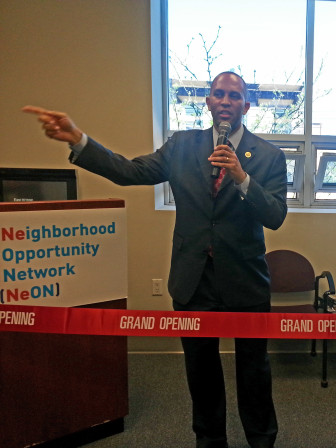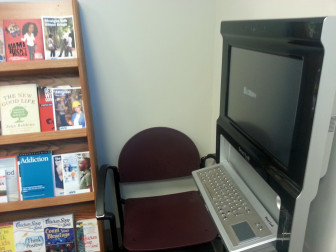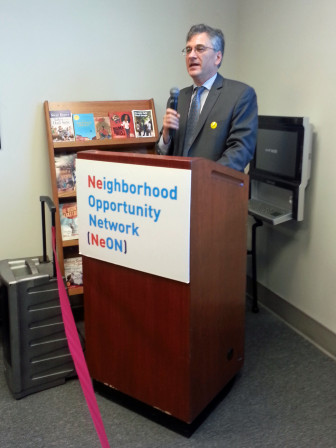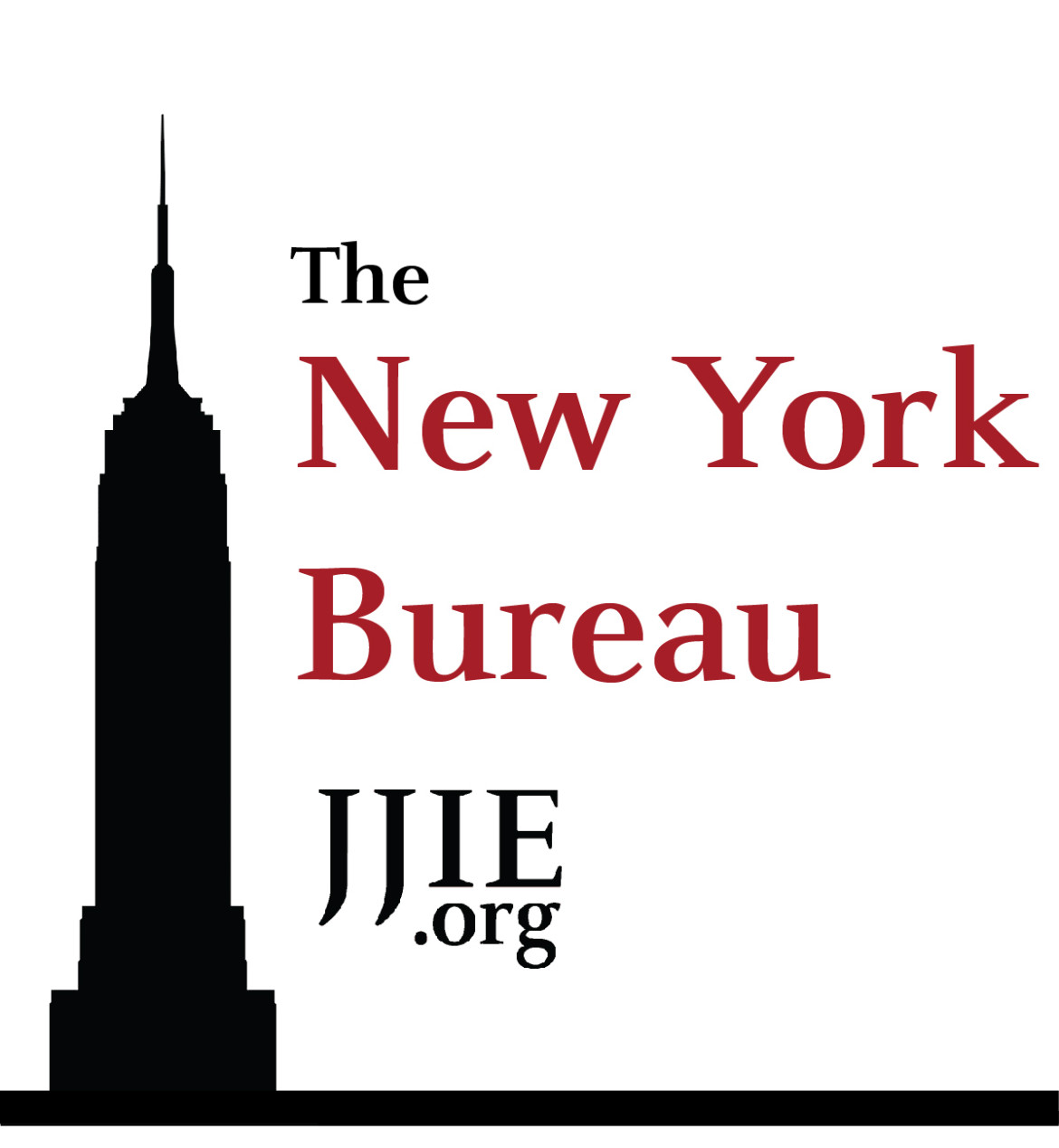
- Officials gathered for the grand opening of the East New York offices of a new department of probation initiative
NEW YORK -- Next to a bookstand furnished with self help books and a shiny new computer station, a young man wearing a plaid button up and khakis shyly stepped up to the podium and took a folded piece of notebook paper from his pocket. He wants to be an architect, but that’s a goal for the future.
Right now, he is working on taking care of his past.
Dayshawn (who asked that his last name not be used in this story) is a high school student who was sentenced to five years probation after committing a felony. He delivered a speech at the opening of one of the city’s new probation sites Thursday in the Brooklyn neighborhood of East New York, where he hopes to make the transition a successful one.
“When I was placed on probation I saw it as punishment for my actions,” said Dayshawn, 18. “I thought the best-case scenario was that it would help me make smarter choices. The worst case scenario was that it would be extremely tough and make life harder.”
Since he began serving his five-year probation sentence about 10 months ago he has enrolled in a rehabilitation program through the Center for Community Alternatives, found a mentor, and completed service projects in his neighborhood. He wanted to share his story.
It hasn’t been a “walk in the park,” but he said he feels like people have invested in him.

- Congressman Hakeem Jeffries
But as recently as two years ago, Dayshawn’s probation experience would have been different. He would have reported to an office in downtown Brooklyn, a bureaucracy that city Probation Commissioner Vincent Schiraldi compared to the “Department of Motor Vehicles on a bad day.”
His parole officer’s main role would have been to check on his school attendance, order a drug test and make sure he hadn’t been rearrested. And statistics suggest he would have been likely to commit another crime in the future.
With the opening of the new office, Dayshawn’s experience, and other juveniles like him in the system, is different because his probation sentence is managed through a Neighborhood Opportunity Network, known by the acronym NeON, an initiative introduced by the city in 2011 as part of Mayor Michael Bloomberg’s Young Men’s Initiative.
The point of the program, said Schiraldi, is to keep those who are serving probation close to home so they can form meaningful relationships with residents and local organizations. Clients report to their local NeON office where they connect with workforce training, mentoring, and substance abuse treatment.
And they’re expected to give back.
“The neighborhoods could suffer from their behavior or they could benefit from their good acts,” Schiraldi said.
The “good acts” are often community service such as cleaning up a park. Rham Robinson, who oversees Dayshawn’s program with the Center for Community Alternatives, said the projects are youth lead. They “canvass the community looking for eyesores” and then come up with a plan to complete projects a few times a month.
U.S. Congressman Hakeem Jeffries toured the facility and helped cut the red ribbon with the words “Grand Opening” printed on it. He said he’s been a long supporter of the NeON program. He described it as a “humane and compassionate way to level the playing field.”
“If you give them a shot, they will show you they can do just as good as others, if not better,” he said, referencing Jackie Robinson.

- NEON Offices
With the opening of the East New York office, there are now six NeON locations in New York City – the others are in Jamaica, Queens; Staten Island; Harlem; and the South Bronx. The city hopes to open another Brooklyn office in Bedford-Stuyvesant this summer.
Megan Kurlychek, a criminal justice professor at the State University of New York in Albany, said local probation programs just make sense – especially when it comes to youth and young adults.
“All too often we take youth out of their communities and we put them in placements in a sterile environment,” said Kurlychek. “Sure they can be successful there, but in the end, they’re going back to the same street where their problems originated.”
And in East New York, those streets are tough. According to U.S. Census Bureau data, the neighborhood has a 10.6 percent unemployment rate compared to the city’s 8.5 percent. More than 30 percent of East New York residents -- about 87 percent of whom are black or Hispanic -- live below the poverty line. The neighborhood also stacks up high numbers when it comes to crime. More people in its two zip codes, 11207 and 11208, are incarcerated than any other zip code in New York City.
NeON also localizes the role of the parole officer, something that Dayshawn’s parole officer, Nicole Bagu, 27, can attest to. Bagu said she has two clients on the block.
“I can be to their house in 2.5 seconds instead of being downtown and far away,” she said.
Kurlychek said she wouldn’t be surprised if clients start popping into the office.

- Probation Commissioner Vincent Schiraldi
“Having the parole officer where the kids are spending their time gives them an ‘in’ that you wouldn’t normally get,” she said. “There’s a different level of trust, and the youth are more likely to open up about their daily challenges – which the parole officer can then help them overcome.”
Parole officers working in NeON offices receive special training that Bagu said teaches them to be more like social workers than law enforcement. And having program supervisors in the community who know their clients is supposed to add a level of accountability to the probation sentence.
“Instead of, ‘did he show up,’ we ask, ‘how did he do; did he like it; did he seem comfortable,” Bagu said.
It’s too early to tell the effects that NeON offices will have on recidivism, but the program has received positive feedback.
Dayshawn’s mother, Rosalyn, 34, said it was difficult for her when her son was sentenced to probation, but she has definitely seen a change in him since he began his sentence. She hopes that NeON will help Dayshawn work on his resume and help him get a job after he graduates from high school.
“He’s been doing projects in the community, and he seems to like it, she said. “And he’s more focused – on track.”
